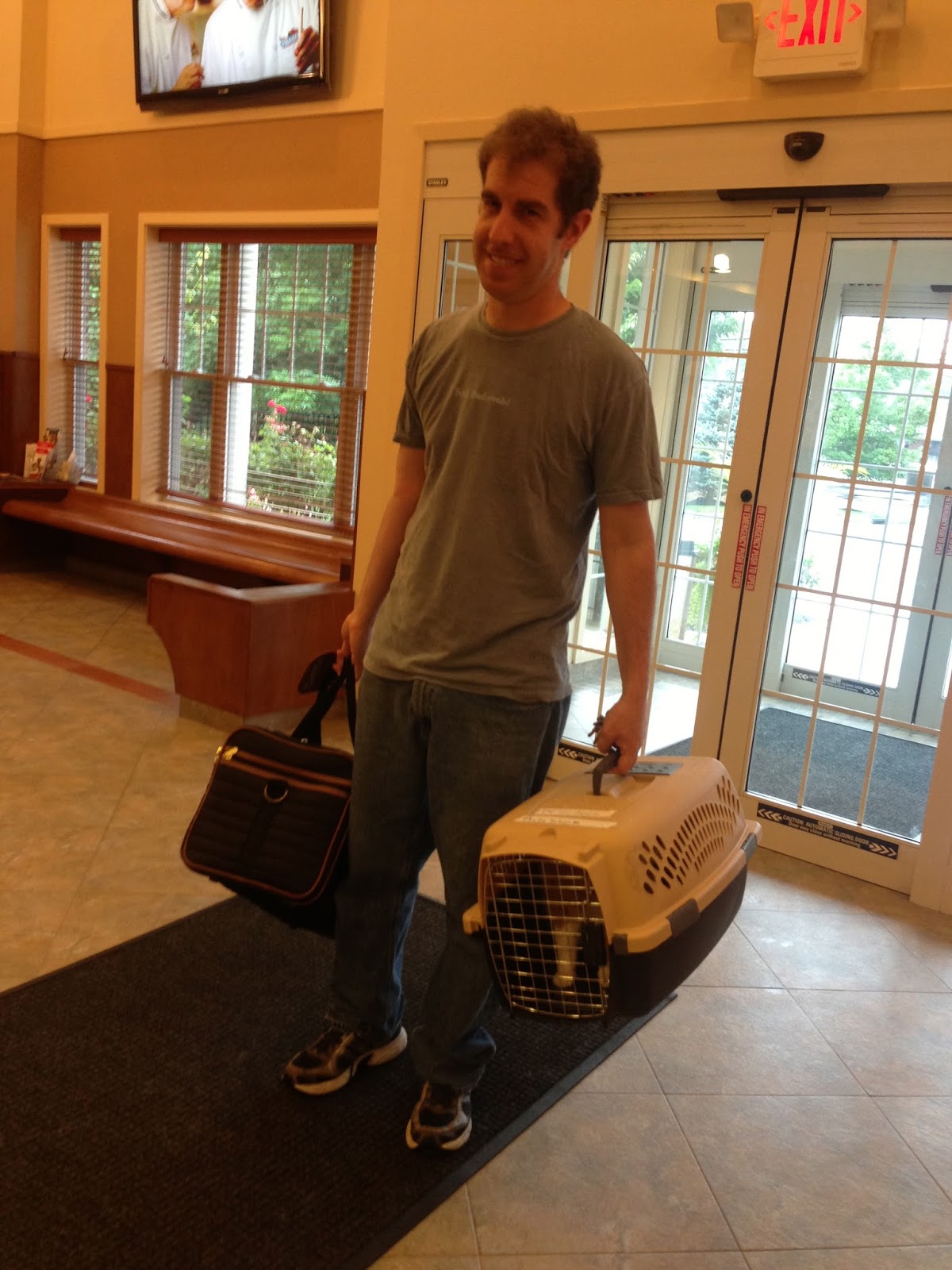I KNOW....
Getting a cat to the vet (let alone multiple cats!!!!) can be VERY challenging.
As a matter of fact, one of the most common reasons we don't see as many cats as dogs in the vet office is because the ordeal can be so difficult for the owners as well as for the cats themselves. Many people feel that the process is so difficult that it just isn't worth the hassle. Well, I'm here to give you a few pointers that can help your kitty (and you) make it to the vet office with a little less of a struggle.
It is no secret that once you bring out that scary cat carrier, all household felines will disappear.
They hear it, the smell it.
They hate it.
(To see how to desensitize them to a comfy, non-clunky carrier, skip to the END of the blog!! )
Anyway- I'll tell you how it goes in my house.
4 cats = 4 carriers. They are usually kept in the garage, which is near the laundry room. I close the laundry room door and bring all the carriers inside (quietly!!). Behind the closed door, they can't see them and there is less time for them to escape. Leave the carriers open.
TIP: A little while before getting the carriers, I close all bedroom and closet doors in the house to limit hiding places.
 |
| All carriers ready.... get set.... |
Then, one by one, I walk around the house and carry one cat at a time into the laundry room. I close the door behind me BEFORE putting that kitty in a carrier.
(If a laundry room isn't an option, a bathroom can work, too. You can put the cat in the bathroom, close the door, and then bring the carrier to them, too.)
 |
.... GO! First kitty victim was Nemo on this particular day.
I recommend holding cats in towels if the tend to panic and scratch. |
Eventually, after every kitty has been caught, brought to the room, and placed in an individual carrier, we are ready to go!
 |
| All four victims have been captured. |
TIP: Many cats will PEE or POOP (or puke...) on their drive. If this happens, I recommend putting that cat in a plastic carrier with a towel or disposable wee-wee pad for easy cleanup upon arrival at the vet hospital.
 |
Jaime HATES this. He likes to pee in the car, hence a plastic carrier is needed.
Sadly, this is how many of my patients appear once they arrive to see me. |
Okay-- once you get to the hospital, we all know how awkward it can be to carry the cats inside. Some carriers are easier to move than others.
If possible, DO NOT carry the cats at your sides. It is awkward, the cats swing all over the place, and the view from that position is very scary to a feline.
 |
| NO!!! |
Instead, carry the box at chest level (or if you have a shoulder strap, use it). This is safer, easier on your back, and provides much more soothing, less rocky, movement for the cats.
Don't be shy- ASK FOR HELP from our staff!! We can help get the other kitties out of the car for you. You can even call from the parking lot.
 |
| YES!!! |
After checking in with our friendly staff, have a seat in a quiet area of the benches, away from dogs if possible. If dogs are barking or the waiting room is loud, we will try to get you into a quiet exam room as soon as we can.
When checking out of the hospital, do not place the cat carrier on the floor. It can be very scary to be a eye-level with doggies... even if they appear friendly :-)
 |
| NO!!! |
Instead, place the cat carrier on the counter. Then, they will not be face-to face with canines.
 |
| YES :-) |
Okay. So how can we make his process even easier? Start fresh and make a carrier a fun, comfy hiding spot, instead of a noisy, scary threat that they only see a few times per year.
1) Buy a new, comfy, light, top-loading carrier. There are many brands, but SHERPA offers great options. Plus, they are approved for many airlines.
2) Leave the carrier out in the open 24/7.
3) Leave the carrier unzipped and in an inviting place.
4) Sprinkle catnip, treats, and FeliWay phermone inside. These things all will invite the kitty to check out the carrier.
5) Be patient. Start this process at least a week before leaving the house with the cat.
6) You might eventually see the kitties exploring the carrier, maybe even going in it. This is good!
7) Eventually, you can easily zip up the carrier with the cat inside, and it will be far less traumatic.
8) You can carry the cat around the house in the carrier, then let them out and let them see that they will NOT die after such an experience.
9) Even after the vet visit, leave the carrier out. Let it become part of the cat's environment. It will then be seen as a comfort, rather than a threat.
10) Be sure to take cute pictures :-)
 |
Here is our comedian, Cosmo. The carrier is not scary or threatening when it's just sitting out on the coffee table.
Notice the Jacob "photo bomb" in the background.....
|
I hope this entry was helpful! Please remember that our staff wants to help you in any way we can. YOU are the most important part of your cat's health care. Without you, we can't examine and treat your feline friends. Call us if you need more helpful hints!
- Dr. Schock





















